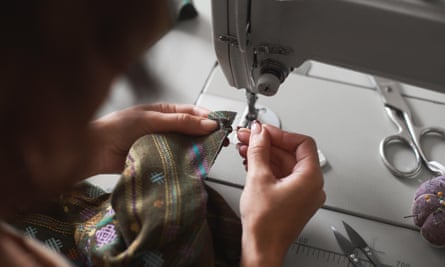Use filters
Be specific in searches. “If you enter ‘green dress’ into the search box on eBay, it will bring back thousands of results, so use the filter,” says Becky Barnes, a sustainable stylist from Bristol, who has been buying exclusively pre-owned clothes since 2017. “You can usually select brand, fabric, length, size – the filtering is more sophisticated than on Vinted.” There are brand new items for sale, too – if you only want pre-owned clothes, select “used”.
Ash Meyer, 19, a student living in Sheffield, is a regular shopper on Depop, buying basics such as joggers and T-shirts as well as “statement pieces, such as vintage football shirts and a 90s Coogi jumper”. The site has 34m items for sale and an average of more than 180,000 new listings every day.
Use a targeted approach. Know the brands you like. Go to their stores and try on a few things to see how they look
Monica Buchan-Ng, London College of Fashion
Meyer sets a price cap on his filters to avoid being tempted by more expensive items. If he’s given himself a budget of £25, he starts looking for lower-priced items first. “I’ll start at £20 and if I can’t find what I’m looking for, I’ll go up to £25. It stops me going over budget. If I find something I like, but it’s too expensive, I set an alert so that the app tells me when similar items come up for sale,” Meyer says.
Monica Buchan-Ng, head of knowledge exchange at the Centre for Sustainable Fashion, based at London College of Fashion, has a one-in, one-out policy for clothes in her own wardrobe, so new purchases are carefully chosen. She advises a targeted approach. “Know the brands you like and how you fit and look in them. Go to their stores, try on a few things, see what size fits you,” she says.
“It can be useful to have a portfolio of brands you are interested in. I’m a huge fan of Jaeger and I know what size fits me, so I keep an eye out. Maybe you like Dries Van Noten from a certain era. Set alerts so that you only see relevant listings.”
Train the algorithms
When browsing, click “like” on any items that appeal. Sanna Moktadir, a 20-year-old student also based in Sheffield, says: “The more pieces you ‘like’, even if you’re not going to buy them, the more the apps will recommend things that are your style, so you have more chance of finding what you want without having to spend ages looking.”

Shop out of season
“I recommend shopping out of season to beat the crowds and get the best price,” says Kirsty Keoghan, the global general manager of fashion at eBay. For example, look for your dream wool coat in the height of summer. Barnes says: “That’s where you’re going to save the most money; if nobody’s after that piece and there’s no demand for it, you can perhaps drive down the price.”
Ask questions
Ask the seller plenty of questions before buying. “Ask for a close up of the label and care instructions; you don’t want dry clean only if you never dry clean clothes,” says Buchan-Ng. “Ask to see areas that are often worn or stained, such as under arms, or inside collars for shirts, or the soles of shoes. I ask a lot of annoying questions. Sometimes people ignore me, but if they do I just move on.”
Barnes asks sellers to provide their own measurements so she can see if they have a similar body shape. “I’ve found that probably eight out of 10 sellers are prepared to provide that for me. There are some who just refuse, and maybe they don’t have a tape measure or can’t be bothered. But I won’t take a risk on it now, because when I have had disappointments, it has mostly been down to sizing.”
Buy bundles
Creating a “bundle” of pieces from one person can bring savings on postage, and the seller may offer a discount, too. Vinted and Depop make this straightforward – go to the seller’s shop page, add the garments you like to the bundle, then buy everything in one transaction.
Learn basic sewing skills

“Build up basic sewing skills like hemming or adjusting a waist band,” says Buchan-Ng. “Then if something arrives and it’s not quite right, you can adjust it and make it work for you.” Maybe you love the fabric a dress is made from, but the cut is wrong or it’s too long, or you’ve found the perfect bag for next to nothing, but it needs some patching up; you could create something new that suits you.
Beware of counterfeits
If you’re buying designer items, do your research. May Berthelot, the anti-counterfeit director at Vinted, says: “Ask for proof of authenticity; this can include a receipt or certificate of authenticity. Ask for photo closeups of details such as the logo, stitching lines, packaging and dust bag, serial number, hardware (zips, clasps etc) and label, to check that they are of high quality.”
Compare details with images on official websites.

